Hop, skip, jump or dance—follow any of these strategies and you may be able to navigate across Bengaluru’s footpaths! The Constitution of India guarantees its citizens the right to move freely throughout the territory of India. However, in cities like ours, enjoying that right seems to require a motor vehicle! As a pedestrian, you may be knocked down as soon as you start your journey.
The National Urban Transport Policy, formulated in 2014, calls for “universal accessibility” and transport services for all including children, the aged and disabled. It goes on to say, “Walking is a zero-emission mode of transport that needs to be the primary focus of a sustainable habitat.” But, we have seen very little action to match these words and thanks to the conditions of our footpaths, walking has long taken a backseat.
“Walking is a zero-emission mode of transport that needs to be the primary focus of a sustainable habitat.” – National Urban Transport Policy, 2014
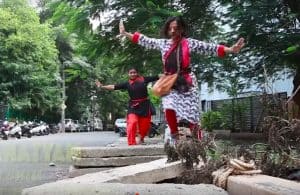
Footpath Bharatanatyam was a popular viral video. https://www.youtube.com/watch?v=o-LqFXghUEA
Today, only 8% of trips in Bengaluru are on foot, and an additional 2% by cycling. Talk to any old Bangalorean, you can get a historical account of how cycling in the bustling Avenue Road was a challenge well worth it or that a walk along Sampige Road in Malleshwaram brimmed with the fragrance of the flowers after which the road is named! This was not so long ago!
These mode shares have come down drastically since 1981 when walking and cycling together accounted for nearly 60 percent of all trips in Bengaluru. Moreover, the mode share of walking and cycling in Bengaluru is now lower than in other Indian cities of similar size. Increasing it should be a key aim of transport policy.
From the authorities perspective, a good question to ask is ‘why invest in pedestrian infrastructure when it caters to only the 8%?’ However, if we give it a little more thought, it is evident that all of us are pedestrians at one point or another in our commute, especially the 42% who use public transport as they begin and end their journeys as pedestrians. Typically, they need to walk to the bus or rail station from their home, and then walk to their destination from the bus or rail station.
A report on transport compiled by the Environmental Management Policy & Research Institute, Karnataka, mentions that the number of deaths from road accidents and the number of vehicles on the road are both increasing at a rate that is more than thrice the rate of population growth in Bengaluru. As a consequence, levels of noise pollution and air pollution from vehicles are substantially above safe levels.
Today, air pollution is a leading cause of death in India accounting for 1.24 million deaths in 2017 of which more than half are younger than 70. Automobiles alone are responsible for between 40% and 80% of air pollution.
In Bengaluru, air pollution levels are increasing each day – levels of particulate matter are higher than reference levels on arterial roads where commuters spend considerable time every day. Transport-related emissions alone account for 68 percent of Nitrogen Oxides and 50 percent of PM2.5 (particulate matter smaller than 2.5 microns) in Bengaluru’s air.
A recent study by the Center for Study of Science, Technology and Policy (CSTEP) and Urbanemissions.info found that Bengaluru’s toxic air is set to get much worse in the next decade. Even if all the infrastructure projects outlined in the BDA Master Plan for 2031 are carried out, there will be a massive increase in air pollution by 2030. Particulate matter concentrations will increase by 70 percent while nitrogen oxide, carbon monoxide and organic compound concentrations are set to more than double.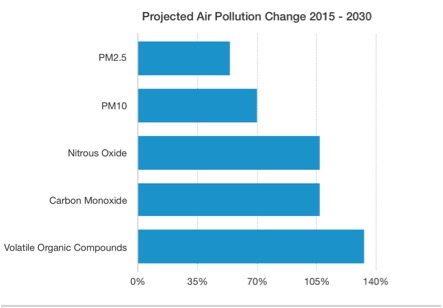
To stem these damaging trends, it is imperative to entice more users to switch from private vehicles to public transport. The National Urban Transport Policy dictates a target mode share of 80 percent from means of transport other than private vehicles, achieving which is in the best interest of all.
Do our leaders care?
Both major national political parties promise new initiatives for non-motorised transport and pedestrian friendly policies in their election manifestos.
The election manifesto of the ruling Bharatiya Janata Party (BJP) promises to “enhance walkability and cycle use.” Along similar lines, the election manifesto of the Indian National Congress (INC) promises to “encourage non-motorised transport, namely walking and cycling”. In both manifestos, there are no further details about how these are to be achieved. N. S. Mukunda, founder President of Citizens Action Forum opines that both parties have merely “reproduced the text book rhetoric” on public transportation.
On pollution, the INC manifesto recognises “air pollution as a national public health emergency” and promises to “significantly strengthen the National Clean Air Programme in order to urgently tackle the problem of pollution” by targeting and reducing all major sources of emission. It also proposes setting up an independent Environment Protection Agency.
The BJP manifesto claims to “have taken effective steps to reduce the level of air pollution in major cities” and promises to reduce the levels of pollution by 35 percent in 102 most polluted cities in the next five years.
Incentivising public transport
One of the popular ways to accomplish this goal is by locating new high density development around public transport stations so that more people can live close to a public transport station and more people can access jobs, shops or other activities by public transport and walking, without requiring a personal vehicle. This is known as “transit oriented development” (TOD).
Many cities around the world have successfully implemented TOD, helping to raise public transport patronage and build compact, dense cities that house a large population whilst minimising land use and environmental impact. These include cities like Singapore and Hong Kong that have been compelled to adopt these strategies to deal with a shortage of land, traditional European cities like Paris and Copenhagen that have directed growth along dense nodes to preserve farmland and countryside, and several cities in the Americas that aim to reduce fuel usage and commute times.
While Bengaluru is growing rapidly and appears crowded, the population density is only 4,381 persons per sq km. Cities like Singapore support twice as much density while retaining substantial green and blue space, and not appearing crowded.
To help build a more compact city, in Bengaluru, the government offers several concessions, in regulations and otherwise, for dense developments around metro stations in Bengaluru. While the policy appears sensible in principle, is it bearing fruit?
Observations from the ground
I conducted a simple experiment to investigate how such ‘transit oriented development’ could help Bengaluru adopt public transport, and explored the neighbourhood around Kanakapura Road in South Bengaluru, between Banashankari and Jayaprakash Nagar metro stations, speaking to several local residents.
“My wife and I both use cars to commute. The metro is convenient for my mother and my children, but when neither of us can drive them, they prefer using Uber or Ola,” said Nitin, one of the residents of a newly built high-rise apartment building right next to the Banashankari Metro Station. No one in his family has used the metro since moving to the apartment six months ago.
This particular building looks imposing and dominates the skyline within a radius of 2 km or so. A total of 94 units are housed in the 25-floor building, with the cheapest costing Rs 16.8 million. Undoubtedly, those who can afford this price can also afford a car, and most households there seem to own at least one car. There is also plenty of parking space within the half hectare (1.22 acre) plot that houses the apartment building.
The complex is secured by a gate and security personnel who regulate all ingress and egress. “We use the metro for our commute,” says Huwe Gowda, one of the security guards referring to himself and his colleague, “but among the residents, three-fourths always use their cars while about one-fourth do walk and use public transport from time to time.”
Another resident of the apartment complex, Rakesh, candidly admitted that while he did not use the metro, he thought “proximity to a metro station would boost the value of his property.” It is a similar picture at the somewhat less upmarket apartment blocks around the Jayaprakash Nagar metro station.
However, if one ventures off the main street in to the smaller side streets, it is a different world altogether. These streets are lined with three or four storey buildings, with one unit per floor, on small plots without a setback from the street. Often, the owner’s family live on one or two floors, renting out the rest.
Most of these plots once housed single family dwellings, which have now been renovated to act as a source of income through monthly rent, ranging between Rs. 12,000 and Rs. 24,000 for a two-bedroom unit. While some buildings do provide parking, more people own motorcycles than cars. There is a roughly even split between public transport and private vehicles as the preferred means of transport among the residents here, perhaps leaning more towards the former.
One resident, Rajesh told me, “It’s easier to commute from here as it is quite close to a metro station. I ride my motorbike to the metro station, park there and use the metro to get to work.” Surprisingly, even people who lived as close as 500m to a metro station used a motorcycle to reach the metro station rather than walking! “It’s hard to walk here because there are cars and bikes honking at you, and who knows, one might hit you,” argues another resident, Lokesh.
It is interesting and instructive to compare the densities of the two kinds of development. The purpose-built, high-rise apartment next to the metro station has an overall density of 188 units per hectare. On the other hand, the four storey building on a side street sits on a 111.5 sq.m (1,200 sq.ft) plot, and with three units, it can boast of a density of 269 units per hectare. Although it might appear counter intuitive, the four-storey building can accommodate more people in less land than the purpose built high-rise apartment building. Add to this the fact that the people in the four storey building on the side street are more likely to use public transport.
Last Mile Solution?
However, the people in our four storey building, and thousands of others like it across Bengaluru do not live right next to the metro station. To use public transport, they face what is known as the “last mile problem,” namely going from their residence to the public transport station at the beginning of their trip, and going from the public transport station to their destination at the end of their trip.
Clearly, the easiest and most cost effective solution for the last mile problem is to increase the effective catchment area of metro stations – the area from which people can realistically walk to the metro station within a reasonable time. This has to start with improving the pedestrian environment to increase the catchment area.
Where do pedestrians walk?
In the areas I investigated, which is representative of many such areas in Bengaluru, most side streets have no footpath at all. The edges of the road, where pedestrians are confined to, often serve as rubbish dumps or areas for temporary storage of construction materials.
Pedestrians must also constantly watch out for motorcycles and auto-rickshaws. Also, since drivers and riders tend to honk aggressively and make turns without indicating, the walk is often stressful. If this weren’t enough, every so often, a goods vehicle comes along which requires nearly the entire width of the road forcing the pedestrian to squeeze into as small an area as possible on the side.
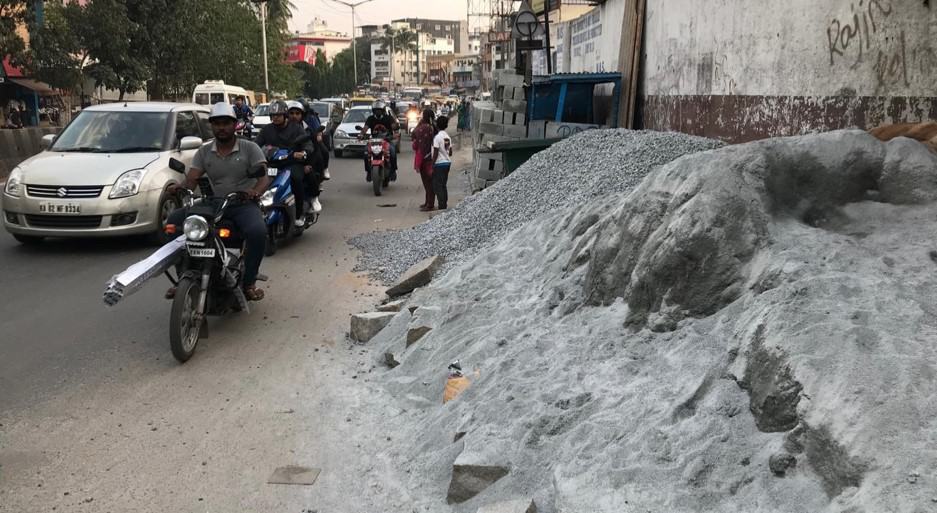
Construction Material Dumped on footpath leaving no room for pedestrians. Pic: The Footpath Initiative
On main roads, the problems are different, but the environment is not any easier for the pedestrian. In sharp contrast to the roads, the surface is very uneven often requiring pedestrians to jump over missing slabs. When roads cross, pedestrians are generally required to climb nearly a foot up and down. These footpaths too often serve as rubbish dumps or areas for temporary storage of construction materials.
At times, their entire width is given over to electricity transformers forcing pedestrians to step on to multi-lane roads with fast moving traffic. Especially in front of commercial establishments, footpaths are often used as parking areas interfering with pedestrian usage. When traffic is really heavy during peak times, footpaths can turn into auxillary turning lanes for motorcycles.
Data on pedestrian safety confirm fears about safety. There have been more than 1,500 pedestrian deaths in Bengaluru during the last five years, making up nearly half of all road accident related fatalities. Nearly 60 percent of crash victims were crossing the road just before the accident, making it the most high risk action one can undertake on a road in Bengaluru.
Who should live near Metro stations and bus stations?
In terms of new development, it may be a better idea to concentrate commercial uses and employment destinations around metro stations rather than high cost, high-rise residential apartments, most of whose residents do not use public transport and prefer to use personal automobiles.
Remedying some of these things, like the quality of footpaths, requires investment and construction. But others only require changes to the law and enforcement. The National Urban Transport Policy calls for an equitable allocation of road space and priority for public transport and non-motorised transport because of its environmental benefits. It calls for “more effective enforcement” and the introduction of “suitable provisions…in the motor vehicles act…to enable stringent penalties for violation.” It is high time for governments to act upon these recommendations.
| This article is part of a series produced under the Citizen Matters – Sustainable Cities Reporting Fellowship and supported by Climate Trends. |
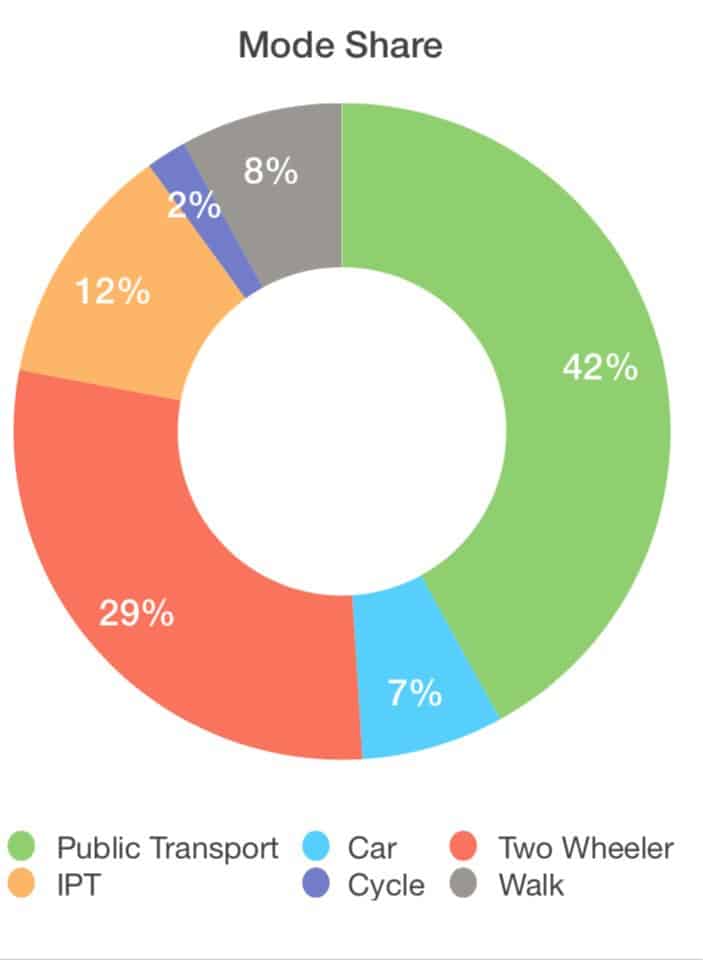
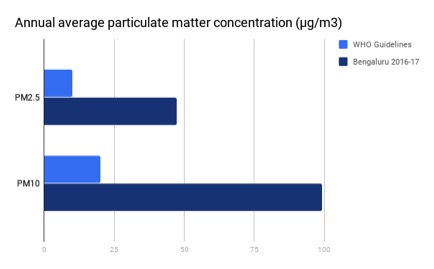
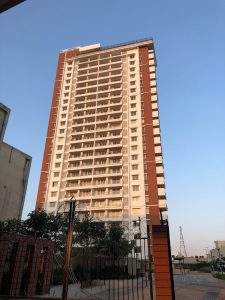

Footpath is not designed like its present state. Someone would have opened the space for repair and left the slabs like that. OR the supporting structure is weak and dislodged the top slabs.
But why there are no small repairs. For everything they ask for reporting. Why not bbmp use their workforce to report problems during their daily cleaning of roads and food paths.
I live in Harlur Road. For the past 1 year Harlur Road and Sarjapur Road is dug up. Pathetic roads forget about Metros or Public transport. Bangalore is on serious decline and I can guarantee you that if things are not improved people will start moving out of this city. People look for better options Bangalore is disgusting on all parameters except the weather. Weather is detoriating and after 5 years Bangalore will lose its only X factor. Most corrupt government